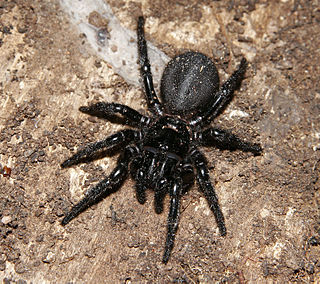
Amaurobiidae is a family of three-clawed cribellate or ecribellate spiders found in crevices and hollows or under stones where they build retreats, and are often collected in pitfall traps. Unlidded burrows are sometimes quite obvious in crusty, loamy soil. They are difficult to distinguish from related spiders in other families, especially Agelenidae, Desidae and Amphinectidae. Their intra- and interfamilial relationships are contentious. According to the World Spider Catalog, 2019, the family Amaurobiidae includes about 275 species in 49 genera.

Hadronyche is a genus of venomous Australian funnel-web spiders that was first described by L. Koch in 1873. Originally placed with the curtain web spiders, it was moved to the Hexathelidae in 1980, then to the Atracidae in 2018.

Orsolobidae is a six-eyed spider family with about 180 described species in thirty genera. It was first described by J. A. L. Cooke in 1965, and was raised to family status from "Dysderidae" in 1985.

Anapidae is a family of rather small spiders with 231 described species in 58 genera. It includes the former family Micropholcommatidae as the subfamily Micropholcommatinae, and the former family Holarchaeidae. Most species are less than 2 millimetres (0.079 in) long.

Hickmania is a monotypic genus of Australian cribellate araneomorph spiders in the family Austrochilidae, containing only the Tasmanian cave spider. The genus was first described by Willis J. Gertsch in 1958, and has been found only in Tasmania. It is the last of an old Gondwanan lineage, long since separated from its closest relatives in South America. It is an icon species for faunal conservation in Tasmania, and is named in honor of V. V. Hickman, a professor at the University of Tasmania, who specialized in spiders. The species name is derived from the Ancient Greek τρωγλοδύτης (troglodytes), meaning "cave-dweller".

Cycloctenus is a genus of Australasian araneomorph spiders in the family Cycloctenidae, first described by L. Koch in 1878. Originally placed with the nursery web spiders, it was transferred to the family Toxopidae because of the distinctive arrangement of its eyes, particularly the enlarged posterolateral eyes. It was moved to the Cycloctenidae in 1967.
Gasparia is a genus of South Pacific araneomorph spiders in the family Toxopidae, and was first described by Brian J. Marples in 1956. Originally placed with the intertidal spiders, it was moved to the Toxopidae in 2017.
Hapona is a genus of South Pacific araneomorph spiders in the family Toxopidae, and was first described by Raymond Robert Forster in 1970. Originally placed with the intertidal spiders, it was moved to the Toxopidae in 2017.
Hulua is a genus of South Pacific araneomorph spiders in the family Toxopidae, and was first described by Raymond Robert Forster & C. L. Wilton in 1973. Originally placed with the intertidal spiders, it was moved to the Toxopidae in 2017.
Neomyro is a genus of South Pacific araneomorph spiders in the family Toxopidae, and was first described by Raymond Robert Forster & C. L. Wilton in 1973. As of May 2019 it contains only three species, all found in New Zealand: N. amplius, N. circe, and N. scitulus. Originally placed with the intertidal spiders, it was moved to the Toxopidae in 2017.
Ommatauxesis is a monotypic genus of Australian araneomorph spiders in the family Toxopidae containing the single species, Ommatauxesis macrops. It was first described by Eugène Simon in 1903, and has only been found in Australia. Originally placed with the Cybaeidae, it was moved to the intertidal spiders in 1967, and to the Toxopidae in 2017.
Otagoa is a genus of South Pacific araneomorph spiders in the family Toxopidae, and was first described by Raymond Robert Forster in 1970. As of May 2019 it contains only three species, all found in New Zealand: O. chathamensis, O. nova, and O. wiltoni.
Toxopsoides is a genus of South Pacific araneomorph spiders in the family Toxopidae, and was first described by Raymond Robert Forster & C. L. Wilton in 1973. Originally placed with the intertidal spiders, it was moved to the Toxopidae in 2017.
Symphytognatha is a genus of dwarf orb-weavers that was first described by V. V. Hickman in 1931.
Ozarchaea is a genus of South Pacific shield spiders that was first described by Michael Gordon Rix in 2006.

Toxopidae is a small family of araneomorph spiders, first described in 1940. For many years it was sunk into Desidae as a subfamily, although doubts were expressed as to whether this was correct. A large-scale molecular phylogenetic study in 2016 led to the family being revived.
Xenoctenidae is a family of araneomorph spiders separated from Miturgidae in 2017.
Myro is a genus of araneomorph spiders in the family Toxopidae, and was first described by O. Pickard-Cambridge in 1876. Originally placed with the Cybaeidae, it was moved to the intertidal spiders in 1967, and to the Toxopidae in 2017.
Laestrygones is a genus of South Pacific araneomorph spiders in the family Toxopidae, and was first described by A. T. Urquhart in 1894.






